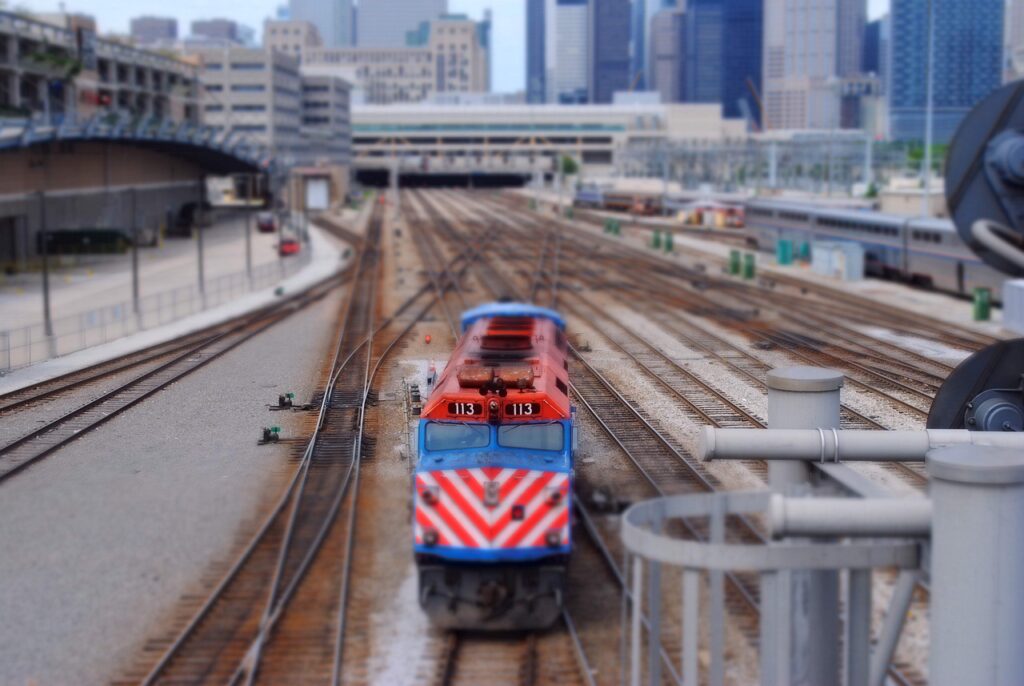The Chicago metropolitan area, home to approximately 3 million residents, boasts an extensive public transportation network managed by the Chicago Transit Authority (CTA), which operates city buses and subways under the supervision of the Regional Transportation Authority (RTA). Both locals and tourists can effortlessly utilize various transport options, such as regular taxis, water cabs, car rentals, and bike-sharing services. In addition, the RTA operates Metra commuter trains and Pace buses, further expanding travel options for visitors and residents alike.
For pedestrians exploring downtown Chicago, the Pedway underpass system is an excellent option, operating on weekdays from 7:00 AM to 5:00 PM. This extensive network spans 40 city blocks and connects over 50 buildings, providing Chicagoans with a convenient and sheltered alternative to navigate the city, particularly during inclement weather.
Now, let’s proceed to different transportation options in Chicago.
Get Around Chicago Using Railroad Transportation
Chicago, renowned as the railroad capital of the United States in a prestigious magazine, boasts an exceptional rail transportation system that outshines many other American cities. It enables convenient access to various neighborhoods and surrounding areas through its extensive train network.
The Chicago ‘L’ subway, a popular public transportation choice among city dwellers, derives its name from the elevated railway upon which a significant portion of the system operates. Additionally, the ‘L’ encompasses underground subway tunnels and street-level sections.
Managed by the Chicago Transit Authority (CTA), the ‘L’ network comprises eight lines (145 stations) – Blue, Brown, Green, Red, Orange, Pink, Purple, and Yellow. The Red and Blue lines offer 24/7 service, with the latter connecting downtown to O’Hare International Airport, making it particularly useful for tourists.
The CTA website features a user-friendly trip planner, along with essential information on fares, schedules, payment methods, and urgent passenger alerts. For real-time tracking of trains and CTA city buses, the website or the Transit Stop: CTA Tracker mobile app is highly recommended.
Metra, the commuter railroad system, encompasses 11 lines (241 stations) covering the entire Greater Chicago area. Even for tourists not venturing beyond the metropolitan area, Metra offers convenient access to different parts of the city, with several routes originating or passing through the city center. The carrier’s website provides Metra line maps, timetables, and other valuable traveler information.
Fares for commuter trains are determined by the number of transportation zones crossed by the passenger, with a total of ten zones. Downtown Chicago falls within zone A. Comprehensive details on ticket purchasing and payment options can be found on the RTA and Metra websites.

Buses in Chicago
Chicago boasts the second-largest bus system in the country, covering not only the metropolitan area but also nearly 50 surrounding suburbs. This extensive network complements the city’s rail system, enabling seamless travel in and around Chicago.
CTA Buses
The CTA city buses provide a reliable alternative to other transportation modes, operating across 128 routes with a combined length of 2,472 km. Bus stops are conveniently located in every district, typically within one or two blocks of each other. A dedicated tracker allows passengers to monitor bus movements in real-time.
The CTA Night Owl service comprises 18 lines that run 24/7, identifiable by the letter N preceding the bus number. This service facilitates nighttime travel between midnight and 5 AM.
The CTA’s online portal features transportation schedules, a comprehensive map of the Chicago Transit Authority system, and information on connections between the city’s train and bus routes.
h3 Pace Buses
For access to Chicago’s outlying neighborhoods, tourists can utilize the Pace commuter bus system. The carrier’s website offers real-time bus tracking, a trip planner, and route schedules. Many Pace terminals are conveniently situated near CTA and Metra train stations and city bus stops.
More Ways To Get Around Chicago
In addition to the previously mentioned transportation options, there are several other ways to get around Chicago:
1. Bike-sharing: Divvy, Chicago’s bike-sharing program, offers thousands of bikes at hundreds of stations across the city. This eco-friendly and healthy alternative is suitable for short trips and sightseeing.
2. Ridesharing: Uber, Lyft, and other ridesharing services are widely available in Chicago, providing a convenient and often cost-effective mode of transportation.
3. Taxis: Traditional taxis can be hailed on the street or found at designated taxi stands. They offer a reliable and comfortable way to travel within the city.
4. Water Taxis: During the warmer months, water taxis operate along the Chicago River and Lake Michigan, offering a unique and scenic way to explore the city. Services like Chicago Water Taxi and Shoreline Water Taxi connect popular attractions and neighborhoods.
5. Walking: Chicago’s downtown area, particularly The Loop and Magnificent Mile, is pedestrian-friendly with well-maintained sidewalks and crosswalks. Walking allows visitors to fully appreciate the city’s architecture and atmosphere at their own pace.
Does It Worth Having/Renting a Car in Chicago?
Whether to have/rent a car in Chicago largely depends on your specific needs, preferences, and itinerary.
Chicago is known for its traffic congestion, especially during rush hours. Finding parking in the downtown area can be both challenging and expensive. If your activities are primarily centered around downtown and well-connected neighborhoods, relying on public transportation may be more convenient and cost-effective.
On the other hand, a car can provide greater flexibility, particularly if you plan to visit more remote locations, explore the Greater Chicago area, or take day trips to nearby attractions. A car rental might be more suitable for travelers who value the freedom to travel at their own pace and explore off-the-beaten-path destinations.
Keep in mind, there are strict laws against driving under the influence (DUI) of alcohol or drugs in Illinois. The legal blood alcohol content (BAC) limit in Illinois is 0.08% for drivers aged 21 and older. For drivers under the age of 21, the BAC limit is 0.00%, meaning they cannot have any alcohol in their system.
Conclusion
By combining these different transportation options, you can easily and efficiently navigate Chicago while experiencing the city’s unique charm.